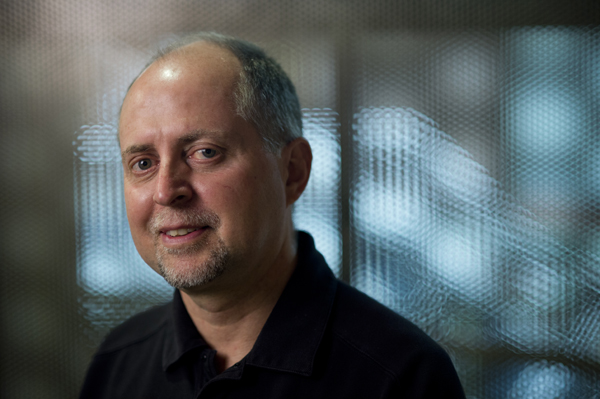The inspired composer

It’s often surprising—and frequently enlightening—to discover the source of an artist’s inspiration.
Ronald Smith, a composer whose work incorporates both acoustic instruments and electronics, is a prime example. In the early 1990s, Smith gravitated toward Swiss-born painter Paul Klee, who dabbled in surrealism and experimented with color theory. Years later, he turned to the silver screen, drawing inspiration from films like Memento and Pulp Fiction to create a series of compositions in their non-linear mold.
“My ideas come from a lot of places,” says Smith, an associate professor of music technology and composition at Northeastern University. “Sometimes visual art serves as a springboard.”
Smith has composed more than 30 pieces of music since the beginning of his professional career in 1986, when he wrote a six-minute duo for the clarinet and tam-tam, a type of gong. Over the past 28 years, he has received many awards and commissions for his work, which critics have hailed as “seductive,” “lustrous,” and “wonderfully evocative.”
In 2010, Smith received a commission from Harvard University’s Fromm Music Foundation, which annually selects a dozen recipients from a pool of approximately 200 applicants. He spent the next 18 months composing a four-part, 23-minute piece for keyboardist Vicky Chow, whom he met in 2009 at an electronic music festival in China. Titled “Piano Book,” the composition draws on Smith’s preoccupation with space, tempo, and rhythmic structures, which harken back to his fascination with the visual arts.
Chow will perform the piece at the Fenway Center in November, capping her weeklong residency at Northeastern. The concert will employ eight-channel spatialization, giving audience members the impression that the sound of her music is enveloping them or moving through the venue. “It’s not an easy piece for a pianist,” Smith says, “but Chow is a terrific player.”
In 2013, Smith received a commission from the Serge Koussevitzky Foundations, which were founded in 1942 in honor of the second wife of the eponymous conductor, composer, and double-bassist. Shortly after receiving the award, Smith began working on a 22-minute composition for guitarist David Tanenbaum and the Del Sol String Quartet, which will perform the piece next spring.
Titled “Tableaux and Tala,” the composition aims to explore the history of the oud, the guitar’s pear-shaped progenitor, as well as other stringed instruments found along the ancient Silk Road.
Smith, meanwhile, has been commissioned to compose two more pieces—one for a solo percussionist, the other for the Boston Modern Orchestra Project—but he’ll focus solely on “Tableaux and Tala” until it’s complete. “Encountering new musical ideas and seeing how they develop is all-consuming,” says Smith, who grew up playing classical guitar, paying his way through college by performing at weddings and cocktail parties. “It absorbs everything.”





